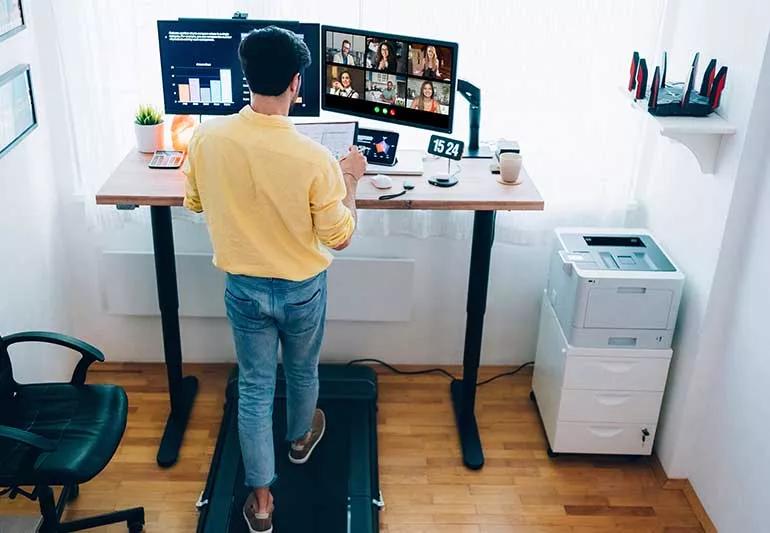You can do squats, planks, pushups or even a get in a quick run all without leaving your desk

The U.S. Centers for Disease Control and Prevention (CDC) recommends we all get at least 150 minutes of exercise each week. That includes a combination of aerobic (heart-pumping) exercise and strength training.
Advertisement
Cleveland Clinic is a non-profit academic medical center. Advertising on our site helps support our mission. We do not endorse non-Cleveland Clinic products or services. Policy
When and how you get that work in is up to you.
Research shows that mini workouts spread throughout the day are as effective as longer ones. That’s good news for people who work at a desk for 40 (or more) hours a week.
Sitting for long periods is never a good idea — you’ll live longer if you get up and move. But if you’re desk-bound for most of the workday, a lunchtime walk isn’t your only option for exercise, says physical therapist and athletic trainer Eric Moogerfeld, DPT.
“Depending on your office situation, you could fit cardio and strength training into your workday,” Dr. Moogerfeld says. Here’s what he recommends for exercising at your desk.
Research shows that short periods (under 10 minutes) of higher-intensity physical activity throughout the day can positively affect weight. Each daily minute of high-intensity exercise lowers your risk for obesity, Dr. Moogerfeld says.
“If you have to work at a desk, there are ways to make your desk work for you,” he adds. “Standing desks help reset your posture, but some desks and equipment offer cardio options as well.”
Exercise machines that are specific to desk workers can be a toughie if you work in an open office space or are on video calls all day, but they can be particularly useful for people who work from home or at least have a private office. Dr. Moogerfeld recommends:
Advertisement
You can still exercise at your desk even if you don’t have the privacy, space or budget for an under-the-desk gadget. These strength-training exercises require nothing more than your own body weight.
And building muscle strength helps you avoid injury, burn calories and regulate your mood.
Dr. Moogerfeld suggests trying these strength-training moves without leaving your desk:
“Isometrics involve contracting (squeezing) and relaxing muscles one at a time,” Dr. Moogerfeld explains. “And it’s the sneakiest way to exercise at work since no one will know you’re doing it.”
Focus on one muscle group at a time, contract it and hold for three to 10 seconds (depending on your fitness level). Work up to three sets of 10 repetitions.
Oblique twists strengthen the muscles that run along either side of your abdomen. Strong obliques help burn fat, support your back and create good posture.
How to do an oblique twist:
Make it more challenging by holding something in your hands (a weight, water bottle or medicine ball), or lift your knees so that your feet don’t touch the floor as you rotate.
Advertisement
Push-ups and planks work your core and upper body at the same time. Consider doing a plank or a couple of push-ups each time you get up from your desk — research shows the more push-ups you can do, the lower your risk of cardiovascular disease.
How to do planks and push-ups:
Your quadriceps (thighs) are the biggest muscle group in your body — and you can strengthen them without leaving your desk chair.
How to do a seated leg extension:
Advertisement
Dr. Moogerfeld suggests you can keep some ankle weights in your desk to make the move harder once you get stronger.
Your calves help you run, walk, jump and balance. Calf raises strengthen them. Begin by doing calf raises while sitting. As you get stronger, put something heavy on your lap to add weight or perform calf raises while standing behind your chair.
How to do calf raises with your chair:
Weakened glutes and tight hip flexors can lead to “dead butt” syndrome — numbness and pain in the buttocks, hips and lower back associated with sitting too much. Doing chair squats before you sit at your desk can help strengthen those areas, Dr. Moogerfeld says.
How to do chair squats:
Whether you’re an exercise enthusiast or just starting to work out, making exercise part of your workday routine may be challenging. To help make it a habit:
Advertisement
“It’s easy for work to get in the way of working out,” Dr. Moogerfeld notes. “But the best way to avoid a sedentary lifestyle is to prioritize exercise and find ways to fit it in throughout the workday.”
Learn more about our editorial process.
Advertisement

You can improve your athletic performance over time by breaking up your workout regimen into focused cycles

Lower-intensity workouts can deliver high-quality health and fitness results

Incremental changes in your exercise routine can improve your strength and endurance over time

Understanding heart rate zones can help you tailor your workout to reach your goals

Increase the size of your muscles by bulking up on protein and focusing on slow, intense movements with progressive overloading

Low-impact exercises help you recover faster between sets, during cool downs and on rest days

Eccentric is slow and steady, while concentric is fast and controlled

Weightlifting can help you build muscle mass, reduce joint pain and increase flexibility to improve your quality of life

Start having sex about 72 hours before ovulation, then at least every other day during your fertile window

Attachment theory suggests that your earliest relationships shape connections throughout your life

It isn’t a recognized mental health disorder, but research shows that problematic social media use can negatively affect your mental health, self-esteem and sleep